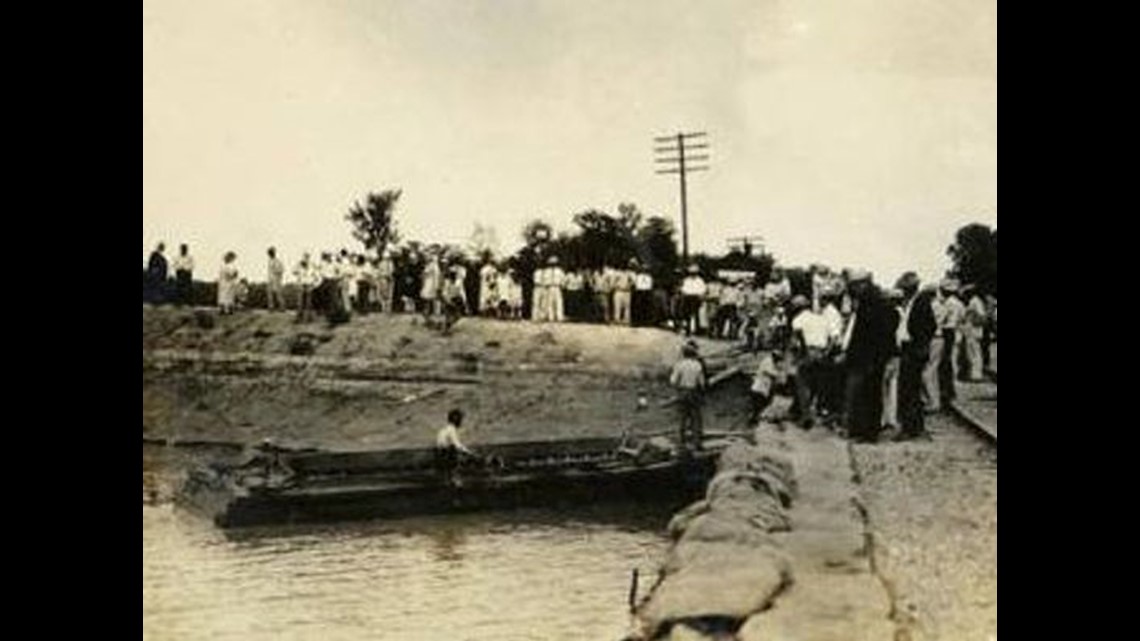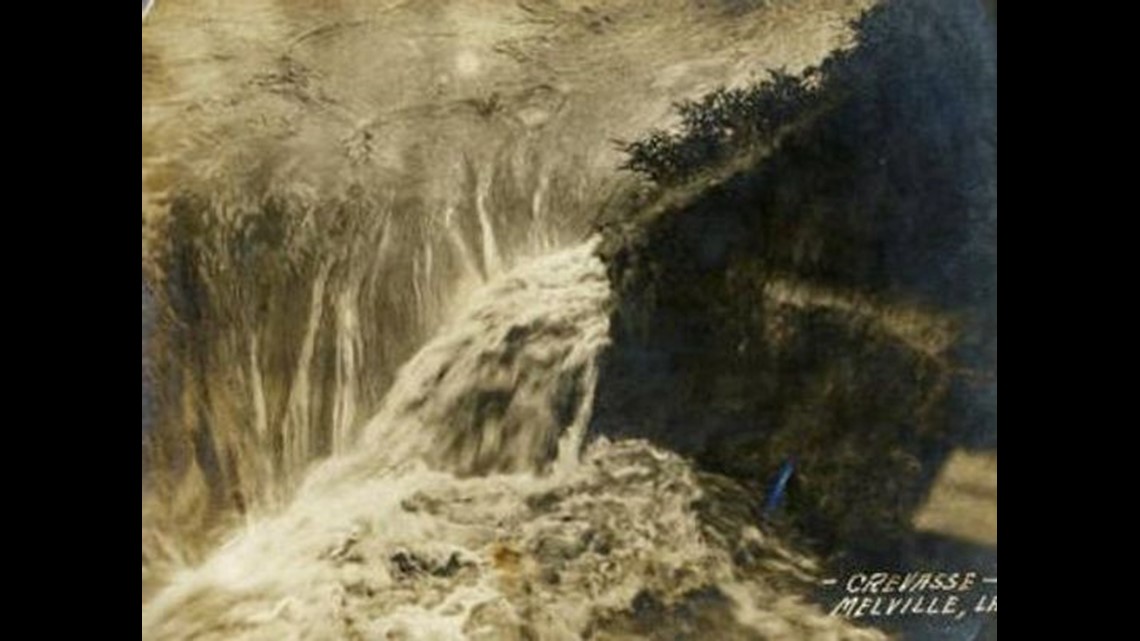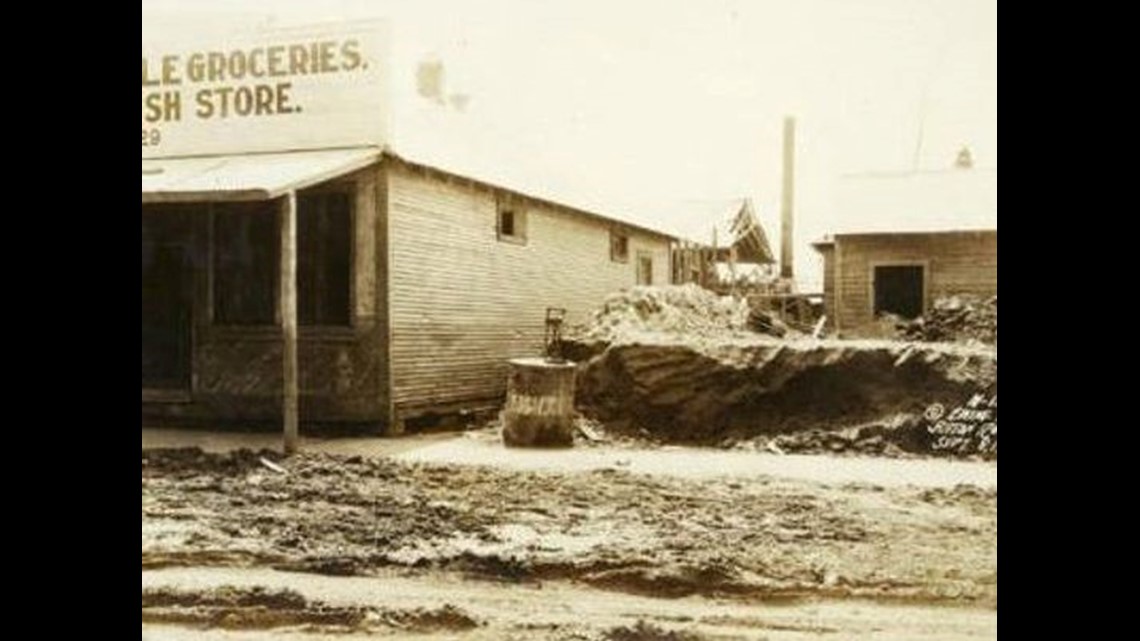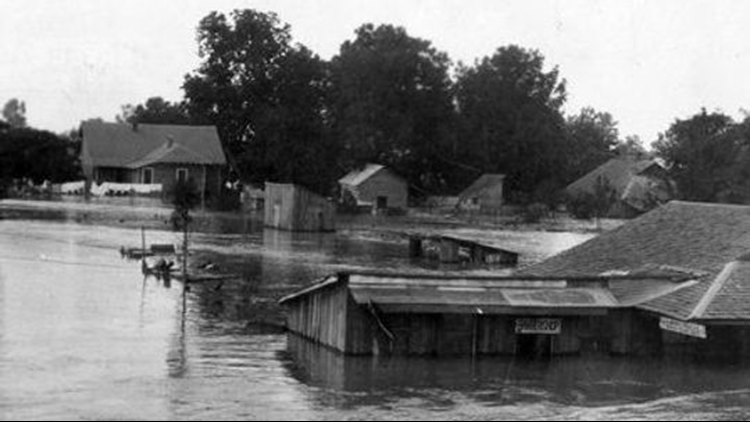Ninety years ago, the Mississippi and Atchafalaya rivers — swollen from months of rainfall — burst through levees, sending muddy water into businesses, homes and farmland across Louisiana.
Families and farm animals sought refuge on rooftops, raised railroad beds and levees. Thousands were left homeless for weeks, even months.
The event, called simply the Great Flood of 1927, would change Louisiana forever.
Nature defeats man's efforts
As heavy rainfall in 1926 continued into the spring of 1927, the Mississippi River began cresting in places like Cairo, Illinois, sending tons of water rushing south to Arkansas, Louisiana and Mississippi.
By April of 1927, the situation was critical. Local and state agencies did what they could to shore up levees along the Mississippi and Atchafalaya rivers and adjoining waterways from Richland Parish south to St. Landry Parish.
On April 27, 1927, 66 members of the Louisiana National Guard's Company B left Lafayette for New Roads in Pointe Coupee Parish to help strengthen levees on the Mississippi River, Locke Mouton of the Acadiana Area Red Cross wrote in the July 24, 1983, Daily Advertiser.
Volunteers from Southwestern Louisiana Institute (now the University of Louisiana at Lafayette), Maurice, Youngsville and Lafayette joined efforts to beef up levees that protected Acadiana, he wrote.
North Louisiana swells
Despite the valiant effort, levees in northeast Louisiana began to fail.
Residents in Rayville, a community in Richland Parish, fought to avert the Mississippi River flood by erecting a 6-mile long levee around the town in a two-week period, according to a May 1981 story in the Monroe News-Star-World.
When James H. Wilkerson, who was 8 at the time, got word that the levee near Rayville broke and the water was heading his way, he and other neighborhood children went to the woods to see for themselves, he wrote in the 1981 News-Star-World report.
"Seeing the dirty brown water snaking through the grass and palmettos was sufficient to make cold chills run up and down one's spine," he said. "Especially when one realized that this water was coming from the Mississippi River. Even at the age of 8 years, I could imagine the expanse of water that would reach from the Mississippi to where we were — 60 miles away."
A boat was tied up at the Jones Pharmacy Drugstore where W.L. Jackson was the pharmacist, Edwin H. Myrick, in the 1981 report, recalled. "And we'd ... row the boat right into the drugstore front door, right on down to ... the pharmacy counter" to give Jackson prescriptions to fill.
Other towns in the area also were not spared.
"A sheet of water up to 15 feet deep in places covered such northeastern Louisiana towns as Lake Providence, Tallulah, Delhi, Winnsboro and Mer Rouge," the News-Star-World reported in the 1981 retrospective.
Much of south Monroe flooded, water reaching as high as the eaves of some homes, the newspaper reported.
Resident Ray Griffin, who was 76 in 1981, recalled the way everyone pitched in to fill and place sandbags around the city. "We stretched those bags from Grayling Lane down South Grand to Oxen Dam," he recalled. "And it held."
Most of downtown Monroe stayed dry as levees and a railroad embankment kept floodwaters at bay, the newspaper reported. Downtown West Monroe wasn't as fortunate as backwater from the Ouachita River flooded that area.
Thelma Sturgeon Smith from Alto in Richland Parish, recalled in 1981 that her family was living in Franklin Parish southwest of Winnsboro near the Oak Grove Baptist Church in May of 1927. While her mother did laundry, boiling clothes in a black pot in the yard, the children played in the yard "when we noticed water running down the road ditches," she said.
The water rose quickly, extinguishing the fire under the black pot and before long, there wasn't a dry spot in the yard. The boys rescued the chickens and placed them on a scaffold out of the water.
A boat eventually took them to a Red Cross camp where they were assigned to a tent with army cots and blankets that was their home for at least two weeks.
Irma Yarborough, a native of Columbia in Caldwell Parish, recalled in the 1981 News-Star-World that on May 7, a dam on a tributary of the Ouachita in Arkansas sent water rising rapidly in Columbia.
"The merchants worked all day through the night trying to scaffold up their store goods. My father, J.D. Yarborough, was one of those whose store was threatened." He used a boat to carry goods from the store to their house, which was on higher ground.
The author and her sister, Rosalie, helped their mother dig up some of her favorite plants so they wouldn't die in the flood. Her grandfather, the Rev. Frank M. Yarborough, who lived with them, "gathered up the few chickens left in the yard and put them in a coop on one end of the porch.
Rosalie Yarborough recalled how they kept a boat tied up at the front steps of the house, "and every afternoon, my mother would get in the boat with her milking pail and paddle out to the edge of a hill where our cow was staked. She would feed the cow and milk her and we would all come back by boat."
Elsewhere, Leonce Leblanc, in a 1975 oral project recorded by Otis Hebert and on file with the UL Lafayette Center for Louisiana Studies,recalled seeing the Atchafalaya River levee break around McCrea in Pointe Coupee Parish. The Red Cross, he said, had chartered a steam boat from Standard Oil Company, where he worked, to evacuate people along with convicts from the Louisiana State Penitentiary at Angola.
"They worked hard, but the levee broke at 3 o'clock in the morning," Leblanc recalled.
Lives were lost in Greenville, Mississippi, he said, and a woman gave birth on a rooftop where her family had climbed to escape the flood.


Flood waters push south
The Daily Advertiser reported floodwaters were racing south due to a main levee break at Moreauville and Bordelonville in Avoyelles Parish.
Daily Advertiser reporter Jim Bradshaw wrote in October 1999 that hundreds of volunteers worked to brace levees along the Atchafalaya River between Port Barre in St. Landry Parish and Henderson in St. Martin Parish.
The May 6, 1927, Daily Advertiser asked Catholic church goers in St. Martinville, Parks and Breaux Bridge to volunteer that Sunday and a special Mass would be held at 4 a.m. to accommodate the volunteers, Bradshaw wrote.
On May 12 or 13, the levee at Bayou des Glaises near Cottonport in Avoyelles Parish, north of St. Landry Parish, failed.
A new break appeared in the Bayou Rouge levee in Avoyelles Parish on May 14, and a levee on Bayou Courtableau between Port Barre and Washington in St. Landry Parish failed the same day.
In Melville, another town on the Atchafalaya River in St. Landry Parish, officials concluded it was hopeless to continue trying to shore up the levees. Urged to leave, residents boarded trains for higher ground in Opelousas, Bradshaw reported.
"The last trainload of people pulled out about midnight May 16. Another train stood ready to roll if the worst happened, hauling to safety the hardy, or foolish souls who stayed behind, even though water from Bayou des Glaises had inundated nearby Palmetto, LeBeau and Rosa," he wrote.
The next day, sirens warned those remaining that 1,500 feet of levee just south of Melville had collapsed.
"Striking swiftly in the early hours of the morning, the gorged Atchafalaya tore aside levee barriers and turned its full force on (Melville) today, driving residents from their homes into the streets, attired in their night clothing," The Daily Advertiser reported May 17, 1927.


"With one mighty rush the water engulfed a hotel building, ripping it from its foundation and tossing it aside to strike residences adjoining," the report continued. "The fire whistle and the Standard Oil plant shrieked a warning as levee guards sped through the streets, firing pistols and rifles and shouting 'crevasse, crevasse.'"
Elizabeth Clutchett was 15 at the time. In a 2002 Daily Advertiser report by James Savage, the 89-year-old recalled her grandmother was up at 5 a.m.hanging laundry when a couple told her the levee at Melville had broken.
"She said, 'Run and go on the levee,'" she recalled, adding she "jumped out the bed in my night clothes," forgetting her favorite doll which was recovered later in the mud.
W.G. McNeil was 6 years old in 1927, sleeping above his father's drug store in Melville.
"About daylight, 5:30 or so, we heard them shooting," he recalled in the 2002 report. "We thought it was a cattle stampede. Mama woke me up and said the levee had broken."
"By the time we got to the levee, we were wading in water. I just carried a cigar box with my marbles," he added.
The Oct. 26, 1999, Advertiser included this eyewitness account of Turner Catledge, a reporter for the Memphis Commercial Appeal: "The water leaped through the crevasse with such fury that it spread into three distinct currents. One force shot straight west, wrecking houses, barns and fences as it went."
A second current traveled north, eroding a section of the railroad embankment, "allowing the water to go up into the town proper and completely inundate it," Catledge wrote. "A third current struck from the south. It swept everything before it. Washtubs, work benches, household furniture, chickens and domestic animals went floating by."
Residents raced to the railroad embankment, the only remaining high ground, the rescue train stranded and of no help. Few had time to save personal belongings.
In the days that followed, water from the levee breaks spread to the south.


Officials on May 18 urged evacuation of a large area that included Port Barre, Leonville, Breaux Bridge and Arnaudville. By the next day, most of Port Barre was under about 6 feet of water and on May 20, the bridge over Bayou Fuselier at Arnaudville collapsed right after refugees from the flood had crossed it, The Advertiser reported.
U.S. Secretary of Commerce Herbert Hoover — who was elected president the following year — visited St. Martinville, warning people to prepare for the flood while those in Breaux Bridge and other communities along Bayou Teche were anxious as the weather service predicted inundation from the raging waters, The Advertiser reported on May 20, 1927.
Eventually, Bayou Teche overflowed its banks, flooding communities like Breaux Bridgge, St. Martinville and New Iberia, though not to the extent that communities to the north suffered.


The aftermath
When the waters of the Great Flood of 1927 receded, officials estimate some 26,000 square miles across seven states were flooded; 700,000 people left their homes and 250-500 people lost their lives.
About 100,000 people in Acadiana fled their homes during the Great Flood of 1927, Savage reported in 2002 for the 75th anniversary. About 81 percent of St. Landry Parish was inundated, while about 67 percent of the land in Iberia and St. Martin parishes going under water.
Much of Lafayette remained dry. About 15,000 acres, including areas along the Vermilion River, suffered the worst of the flooding in Lafayette, according to reports.
Lafayette served as host to around 26,000 refugees in Red Cross centers established in May of 1927, Mouton reported in 1983.
"Tent cities sprung up overnight at the Lafayette fairgrounds, now the municipal golf," and at Holy Rosary Institute, he wrote.
Red Cross volunteers served about 50,000 meals a day in Lafayette alone, Mouton wrote.
Similar Red Cross refugee centers were operated at Opelousas, New Iberia, Franklin and Baton Rouge. All were closed by the end of August that year, Mouton wrote.
Jim Bradshaw wrote in "Great Flood of 1927" for Know Louisiana, wrote, "the Red Cross provided seed, tools, and rations to farm families facing the daunting task of surviving the winter and starting a new crop in the spring. Some six hundred prefabricated cabins were sent to St. Martin Parish and more like them elsewhere to temporarily replace destroyed housing."
Many black tenant farmers, driven from their land by the flood, moved north to cities like Chicago and Detroit, Bradshaw wrote.
The 1927 flood demonstrated the government's levees only policy for controlling the Mississippi River was inadequate. The Flood Control Act of 1928 authorized the U.S. Army Corps of Engineers to build levees, diversions and spillways for flood control. It would forever change the landscape of Louisiana.
The Bonnet Carre Spillway was the first diversion structure built in Louisiana as a result of the 1927 flood. It's used to discharge water into Lake Pontchartrain, relieving pressure on Mississippi River levees around New Orleans.
Another flood control structure and spillway was built in the 1950s at Morganza to divert water from the Mississippi River into the Atchafalaya River Basin, relieving pressure on levees from Baton Rouge to New Orleans.



